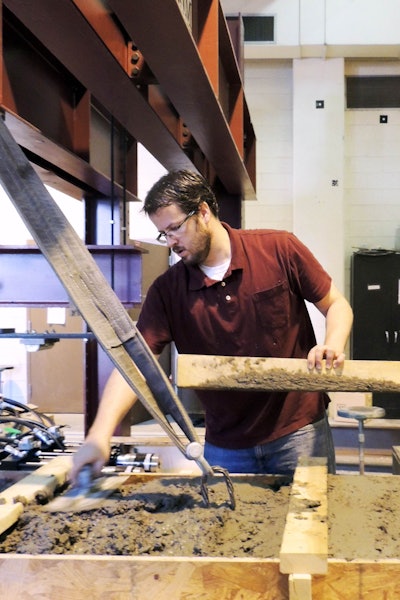 NMSU Assistant Professor of Civil Engineering Brad Weldon is working with the New Mexico Department of Transportation on the construction of the first bridge in the U.S. to be built with non-proprietary Ultra High-Performance Concrete comprised of local materials. (NMSU photo by Linda Fresques)
NMSU Assistant Professor of Civil Engineering Brad Weldon is working with the New Mexico Department of Transportation on the construction of the first bridge in the U.S. to be built with non-proprietary Ultra High-Performance Concrete comprised of local materials. (NMSU photo by Linda Fresques)The New Mexico State University Bridge Inspection Program has been working with the state department of transportation since the 1950s on bridge inspections across the state, an effort that helps prepare the next generation of engineers for the endeavor.
Professional engineers supervise co-op undergraduate students from the school’s College of Engineering while performing on-site inspections. These students travel throughout the state and inspect roughly 150 bridges during a six-month assignment. Graduate students in the program that focus in structural engineering perform load capacity ratings.
All inspections and ratings follow standards set for the by the New Mexico Department of Transportation (NMDOT) the Federal Highway Administration (FHWA) and the American Association of State Highway and Transportation Officials (AASHTO).
“The major goal of the NMSU Bridge Inspection Program is to ensure that highway bridges continue to provide safety and serviceability to the traveling public,” says David Jáuregui, department head of civil engineering and director the program. Jáuregui oversses a group of 10 graduate and eight undergraduate students, two professional engineers and three NMSU professors.
“The documentation that we provide to the NMDOT is used to make decisions related to future maintenance, rehabilitation, retrofit or replacement of structures,” he adds. “The basic approach in which an engineer would inspect any type of structure that experiences some type of damage imposed by an event, such as an overload, earthquake, flood or wind, can be related to bridge inspection. NMSU students participating in the program gain technical expertise and valuable experience they can apply in the evaluation of various structural systems such as bridges, buildings, culverts and even historical monuments.”
But the program work doesn’t just focus on bridge inspection skills. Jáuregui says the students are being taught forensic engineering methodologies.
“An added benefit of the program is that once the students finish this six-month appointment they are given other opportunities through the NMSU Department of Civil Engineering to pursue applied research related to capacity evaluation of structures, which directly ties into the inspection,” he explains. “We are investigating and developing analytical and experimental techniques to determine the load capacity of New Mexico bridges, in particular those without design plans, and other states have expressed interest in adopting our procedures.”
Other work involves research that benefits both the program and the NMDOT. An example is work being done on bridge girders constructed from ultra-high performance concrete aimed at creating better bridge design procedures.
This fortified concrete has a dense microstructure and steel fibers, and has “increased” compressive strength—features that can extend the design lives of bridges compared to typical concrete. For example, normal strength concrete (4,000-6,000 psi) bridges are designed to last about 50 years, but the enhanced concrete mix (22,000 psi) could give a bridge up to a 150-year design life.
The next step in the research would be to use this new concrete mix in the construction of a bridge. It would be the first using concrete of this strength, as it is not included in any bridge design specifications in the country.
“Students come out of the program with a very special and unique set of skills that is not totally available at other universities in the U.S. I’m very proud to be the director of this program and appreciative of the collaboration we have with the NMDOT in bridge-related projects that contribute to the safe travel of the public here in New Mexico,” Jáuregui says.














